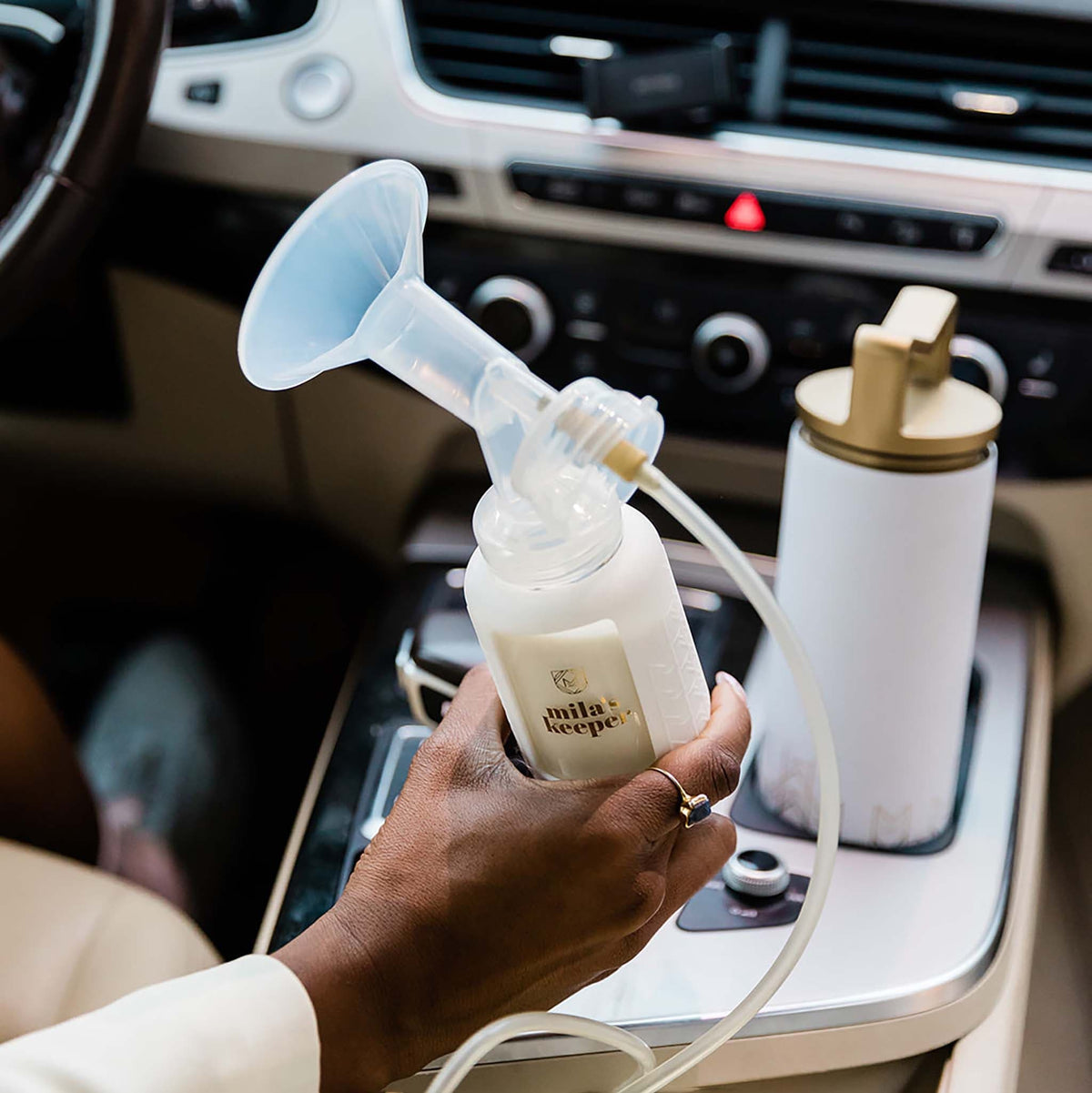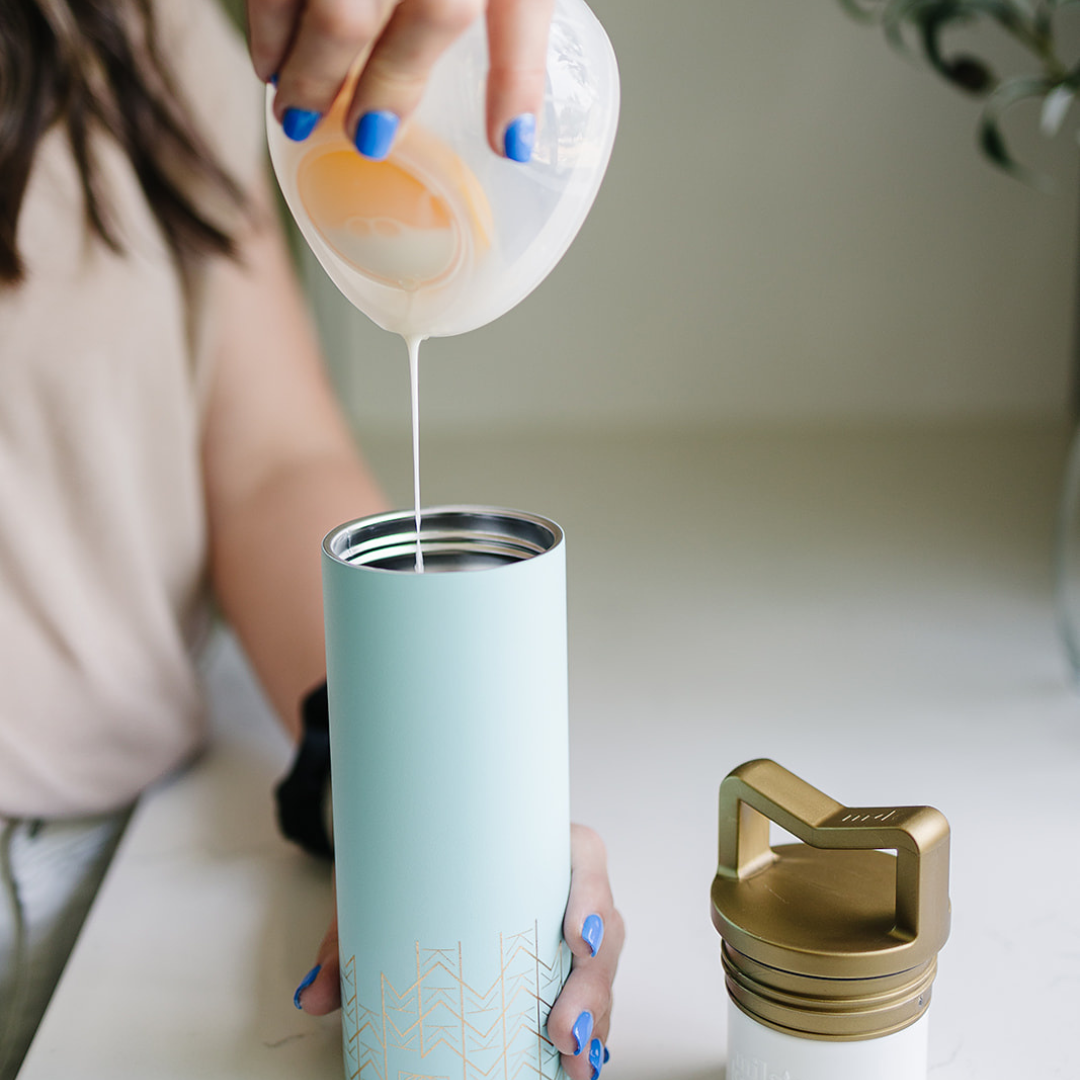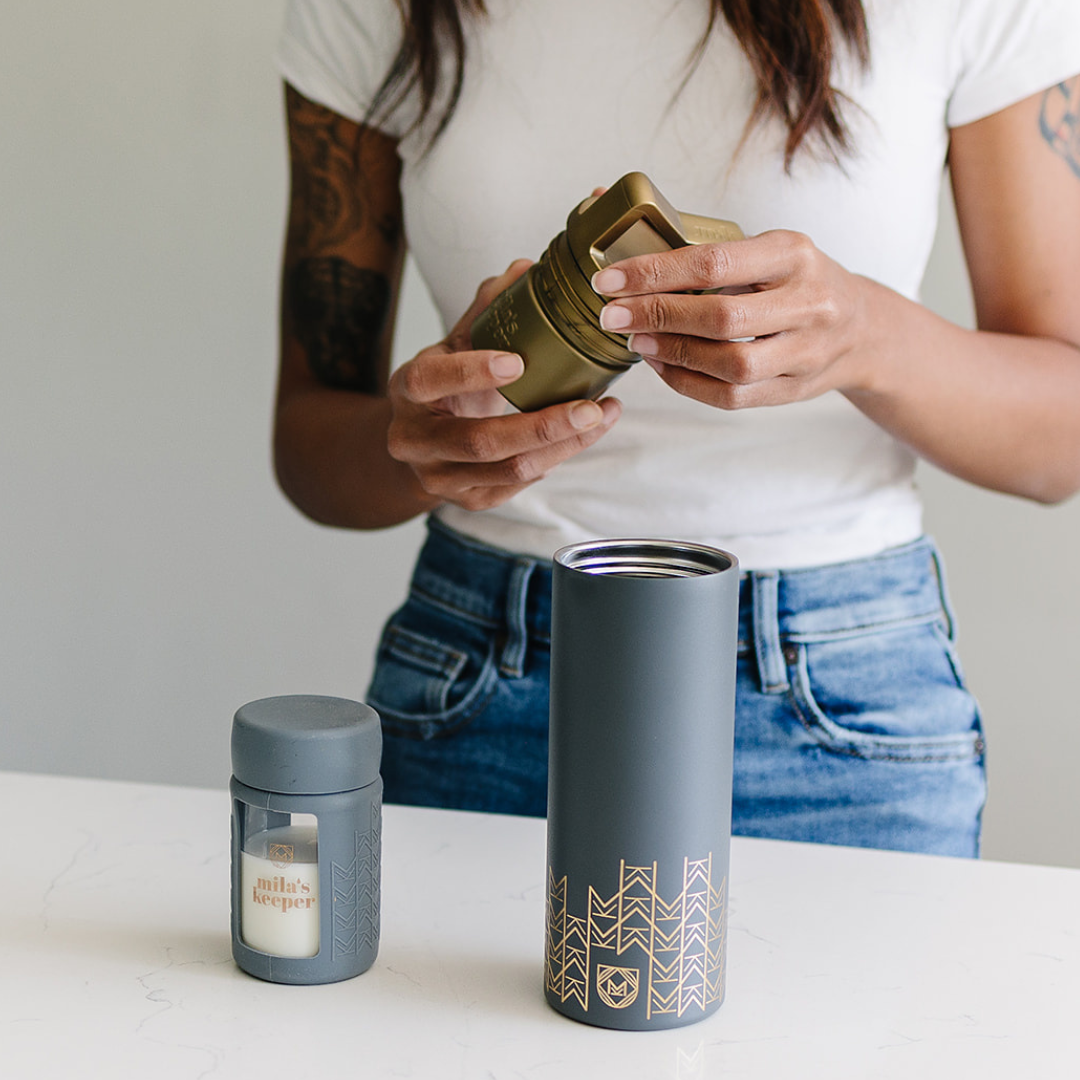As you navigate the postpartum phase, finding balance between caring for your baby and taking care of yourself becomes essential. That's where postpartum yoga comes in.
In this comprehensive guide to postpartum yoga for breastfeeding moms, we'll explore how this ancient practice can help you restore strength, flexibility, and inner peace during this transformative time.
Whether you're a seasoned yogi or a beginner, postpartum yoga offers a gentle and nurturing approach to self-care. We'll get into different yoga poses that target common postpartum concerns like regaining core strength, relieving tension in the shoulders and upper back, and enhancing overall relaxation. We'll also discuss the benefits of postpartum yoga for breastfeeding moms, including improved milk supply, reduced stress and anxiety, and increased energy levels.
So, grab your yoga mat and join us on this journey of self-discovery and rejuvenation. Let's find the balance together as we nourish our bodies, minds, and babies through the practice of postpartum yoga.
Postpartum Yoga: A Path to Wellness for Breastfeeding Moms
The postpartum phase is a time of immense physical and emotional changes. Your body has gone through an incredible transformation during pregnancy and childbirth, and it's important to give yourself the time and space to heal and recover. Postpartum yoga provides a gentle and effective way to reconnect with your body, rebuild strength, and find inner balance.
One of the key benefits of postpartum yoga is its ability to help restore core strength. During pregnancy, your abdominal muscles and pelvic floor undergo significant stretching and weakening. Postpartum yoga poses can help strengthen and tone these muscles, providing support for your spine and pelvic organs. By gradually rebuilding core strength, you can reduce the risk of back pain, pelvic floor dysfunction, and other postpartum issues.
In addition to core strength, postpartum yoga focuses on relieving tension in the shoulders and upper back. The physical demands of breastfeeding can often lead to tightness and discomfort in these areas. Gentle stretches and poses like the Cat-Cow Pose and Shoulder Rolls can help release tension, improve posture, and alleviate common breastfeeding-related aches and pains. Regular practice of these poses can also help prevent the development of chronic tension and promote overall relaxation.
Beyond the physical benefits, postpartum yoga offers a range of mental and emotional advantages for breastfeeding moms. The practice of yoga involves deep breathing, mindfulness, and meditation, which can be especially beneficial during this time of hormonal fluctuations and sleep deprivation.

Reconnecting with Your Body Through Yoga Postpartum
Through gentle movements, breathwork, and mindfulness, yoga helps women navigate the complexities of their postpartum bodies with compassion and understanding.
One of the key ways yoga supports postpartum recovery is by promoting body awareness. After giving birth, you might experience a disconnect from your body as you adjust to the physical changes that come with motherhood. Yoga offers a safe space to explore these changes mindfully, helping new moms regain trust in their bodies and learn to move with ease and grace.
Beyond the physical benefits, yoga postpartum also nurtures emotional well-being. The practice encourages self-compassion and mindfulness, helping you navigate the emotional rollercoaster that often accompanies the postpartum period. By tuning into both breath and body, you can cultivate a sense of calm and inner peace, which can be especially beneficial during the challenging early days of motherhood.
Yoga can also provide a sense of community and support for new moms. Attending postpartum yoga classes can allow you to connect with others who are going through similar experiences, fostering a sense of belonging and solidarity. Check around locally for mommy and me yoga classes that allow you to bring your baby and will take you through yoga poses that you can do with your baby.
Embracing Postnatal Yoga: Benefits Beyond Fitness
Postnatal yoga, also known as postpartum yoga, goes beyond the physical benefits of fitness. It offers a holistic approach to healing and nurturing your body and mind during the postpartum period. Here are some of the key benefits of embracing postnatal yoga as a breastfeeding mom:
- Improved Milk Supply: The practice of postnatal yoga might help stimulate milk production and enhance the flow of breast milk. Certain yoga poses, such as the Cow/Cat Pose and the Cobra Pose, gently massage the breasts and stimulate the mammary glands. This can be particularly beneficial if you're experiencing any challenges with milk supply or if you want to maintain a healthy milk production.
- Reduced Stress and Anxiety: The postpartum period can be overwhelming and stressful, with the demands of caring for a newborn and adjusting to your new role as a mother. Postnatal yoga provides a sanctuary where you can release tension, quiet your mind, and cultivate a sense of inner calm. The deep breathing and relaxation techniques practiced in yoga can help reduce stress hormones and promote a state of relaxation and well-being.
- Increased Energy Levels: Sleep deprivation is a common challenge for breastfeeding moms, and it can leave you feeling exhausted and drained. Postnatal yoga can help boost your energy levels by increasing blood flow, improving circulation, and rejuvenating your body and mind. The gentle movements and stretches in yoga can help relieve fatigue and promote a sense of vitality and overall well-being.
- Enhanced Posture and Body Alignment: Pregnancy and breastfeeding can take a toll on your posture, often leading to rounded shoulders and a forward head position. Postnatal yoga focuses on realigning the spine, improving posture, and releasing tension in the upper body. By practicing yoga regularly, you can correct postural imbalances, alleviate discomfort, and promote optimal body alignment.
- Emotional Healing and Self-Care: The postpartum period is a time of emotional upheaval, as you navigate the challenges of motherhood and adjust to the changes in your body and identity. Postnatal yoga provides a safe and nurturing space to process and release emotions, promoting emotional healing and self-care. By taking the time to connect with yourself on a deeper level, you can cultivate self-compassion and strengthen your emotional well-being.

10 Postpartum Yoga Poses for Safe and Effective Practice
Postpartum yoga offers a wide range of gentle and effective poses that can help you reconnect with your body, rebuild strength, and find inner balance. Here are 10 postpartum yoga poses that are safe and beneficial for breastfeeding moms:
- Bridge Pose (Setu Bandha Sarvangasana): Lie on your back with knees bent and feet hip-width apart. Press your feet into the mat and lift your hips off the ground, keeping your knees in line with your ankles. Hold for a few breaths, then slowly lower your hips back down. This pose strengthens the core and glutes, while also stretching the chest and shoulders.
- Pelvic Tilts: Lie on your back with knees bent and feet flat on the ground. Inhale and tilt your pelvis forward, pressing your lower back into the mat. Exhale and tilt your pelvis backward, arching your lower back away from the mat. Repeat this movement for several breaths, focusing on engaging the pelvic floor muscles. Pelvic tilts help strengthen the core and pelvic floor muscles, promoting stability and alignment.
- Cat-Cow Pose (Marjaryasana/Bitilasana): Start on your hands and knees, with your wrists under your shoulders and your knees under your hips. Inhale and arch your back, lifting your chest and tailbone towards the ceiling (Cow Pose). Exhale and round your back, tucking your chin towards your chest and drawing your belly button in (Cat Pose). Flow between these two poses for several breaths, focusing on the movement of your spine. Cat-Cow Pose helps release tension in the spine, stretch the chest and shoulders, and improve flexibility.
- Shoulder Rolls: Sit comfortably with your spine tall and your shoulders relaxed. Inhale and lift your shoulders towards your ears, then exhale and roll them back and down. Repeat this movement for several breaths, focusing on releasing tension in the shoulders and upper back. Shoulder rolls can help alleviate tightness and discomfort in the upper body, promoting relaxation and improved posture.
- Boat Pose (Navasana): Sit on your mat with your knees bent and feet flat on the ground. Inhale and lift your feet off the ground, balancing on your sitting bones. Extend your arms parallel to the ground, palms facing each other. Engage your core and lengthen your spine, finding balance in the pose. Hold for a few breaths, then slowly lower your feet back down. Boat Pose strengthens the abdominal muscles, improves balance, and tones the core.
- Plank Pose (Phalakasana): Start on your hands and knees, with your wrists under your shoulders and your knees under your hips. Step your feet back, coming into a high push-up position with your body in a straight line. Engage your core, lengthen your spine, and gaze slightly forward. Hold for a few breaths, then lower your knees back down. Plank Pose strengthens the core, arms, and shoulders, promoting stability and overall strength.
- Child's Pose (Balasana): Start on your hands and knees, then sit back on your heels. Lower your forehead to the mat, extending your arms forward or resting them along your sides. Relax your shoulders and take slow, deep breaths. Stay in this pose for several breaths, focusing on releasing tension and promoting relaxation in the body. Child's Pose gently stretches the lower back, hips, and shoulders, providing a sense of calm and grounding.
- Thread the Needle Pose (Parsva Balasana): Start on your hands and knees, with your wrists under your shoulders and your knees under your hips. Inhale and lift your right arm towards the ceiling, twisting your torso slightly. Exhale and thread your right arm under your left arm, reaching towards the left side of your mat. Rest your right shoulder and ear on the mat, and extend your left arm forward or rest it along your side. Hold for a few breaths, then switch sides. Thread the Needle Pose releases tension in the shoulders and upper back, while also stretching the hips and spine.
- Warrior II Pose (Virabhadrasana II): Stand with your feet wide apart, facing forward. Turn your right foot out to the side, and bend your right knee, aligning it with your ankle. Keep your left leg straight and strong, with your foot turned slightly in. Extend your arms out to the sides, parallel to the ground, and gaze over your right fingertips. Hold for a few breaths, then switch sides. Warrior II Pose strengthens the legs, opens the hips, and improves overall stability and focus.
- Corpse Pose (Savasana): Lie on your back with your legs extended and your arms resting alongside your body, palms facing up. Close your eyes and allow your body to completely relax into the mat. Take slow, deep breaths and let go of any tension or thoughts. Stay in this pose for several minutes, focusing on deep relaxation and surrender. Corpse Pose promotes deep relaxation, reduces stress, and allows for integration and reflection.
If you prefer to follow along with an instructor, search online to find a routine that you can easily do at home.
When Can I Do Yoga Postpartum? Timing & Considerations
The timing of when you can start practicing postpartum yoga will depend on various factors, including your overall health, the type of birth you had, and any specific recommendations from your healthcare provider. It's important to listen to your body and give yourself enough time to heal before engaging in any physical activity.
In general, it's recommended to wait until you have received clearance from your healthcare provider, usually around six weeks postpartum. This allows your body to recover from childbirth and ensures that any potential complications or issues have been addressed. However, it's important to note that every woman's postpartum journey is unique, and it's crucial to individualize your approach based on your specific circumstances.
When you do start practicing postpartum yoga, it's important to approach it with awareness and care. Here are some considerations to keep in mind:
- Start Slow: Begin with gentle and simple poses that focus on reconnecting with your breath and body. Listen to your body and avoid any movements or poses that cause pain or discomfort.
- Modify as Needed: Honor your body's needs and modify poses as necessary. For example, if you have diastasis recti (separation of the abdominal muscles), avoid poses that strain the core or exacerbate the separation. Work with a knowledgeable yoga instructor if you need guidance on modifications.
- Use Props: Props like blocks, blankets, and straps can provide support and stability as you ease back into your practice. They can help you maintain proper alignment and prevent unnecessary strain.
- Stay Hydrated: Breastfeeding moms have increased fluid needs, so make sure to drink plenty of water before, during, and after your yoga practice. Staying hydrated is essential for both your own well-being and milk production.
- Listen to Your Body: Pay attention to any sensations or discomfort during your practice. If something doesn't feel right, modify or skip the pose. Remember that your body has gone through significant changes, and it's important to be gentle and compassionate with yourself.
Always consult with your healthcare provider before starting any exercise program, including postpartum yoga. They can provide personalized guidance based on your specific needs and medical history.

Postpartum Hot Yoga: Is It Right for You
Hot yoga has gained popularity in recent years, offering practitioners a challenging and sweat-inducing practice. However, when it comes to postpartum yoga, it's important to consider the potential risks and benefits of practicing in a heated environment.
Hot yoga typically takes place in a room heated to around 95-105 degrees Fahrenheit with high humidity. While some individuals find this environment invigorating and detoxifying, it may not be suitable for all postpartum moms.
Postpartum women are more susceptible to dehydration due to the increased demands of breastfeeding and hormonal changes. Practicing hot yoga can further contribute to fluid loss, increasing the risk of dehydration. Dehydration can have adverse effects on milk supply, energy levels, and overall well being.
Additionally, postpartum women may still have relaxin, a hormone that softens ligaments and joints during pregnancy, present in their bodies. The heat and humidity of hot yoga can increase the risk of overstretching or straining these vulnerable areas.
If you're considering hot yoga postpartum, it's important to consult with your healthcare provider and listen to your body. If you do decide to practice hot yoga, be sure to take extra precautions to stay hydrated, modify poses as needed, and pay attention to any discomfort or pain.
Conclusion: Empowering your postpartum journey through yoga and breastfeeding
The postpartum period is a time of immense change and adjustment, both physically and emotionally. It's a time when self-care becomes essential, as you navigate the demands of motherhood and the needs of your baby. Postpartum yoga offers a gentle and nurturing approach to self-care, allowing you to restore strength, flexibility, and inner peace.
By incorporating postpartum yoga into your routine, you can address common postpartum concerns like regaining core strength, relieving tension in the shoulders and upper back, and enhancing overall relaxation. The benefits of postpartum yoga extend beyond physical fitness, encompassing improved milk supply, reduced stress and anxiety, and increased energy levels.
Remember to listen to your body, honor its needs, and seek guidance from qualified professionals for your postpartum fitness tips. Embrace the practice of yoga and breastfeeding as tools for empowerment and self-discovery. Together, let's find the balance and nourish our bodies, minds, and babies through the transformative practice of postpartum yoga.
Keep Reading related blog: Exercise and Breastfeeding for Outdoor Enthusiasts
A female-designed and female-run company, Mila's Keeper is on a mission to empower women to thrive during their breastfeeding journey by offering reusable, eco-friendly breast milk storage solutions for their day-to-day needs. Get the latest tips and info on Mila's Keeper products by following us on Facebook, Twitter, Instagram, Pinterest, and LinkedIn.























